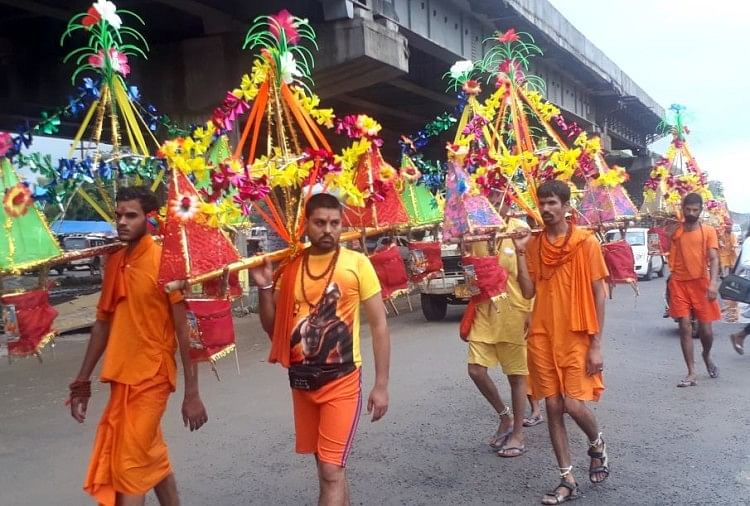Introduction:
Embark on a fascinating journey through the Kanwar Yatra or Kavaḍ Yatra, a sacred pilgrimage deeply cherished by devout Hindus. As the monsoon descends, devotees of Lord Shiva, affectionately known as Shiva Kavadiyas or “Bhole,” set out on this timeless spiritual adventure. Picture this – a sea of devotees carrying Kanwars (Kavads) on their shoulders, on a mission to fetch water from the holy Ganges and anoint Mahadev Bhole Bhandari. In this article, we’ll delve into the rich history, significance, and everything you need to know about the Kavad Yatra, a unique fusion of faith, tradition, and unwavering devotion.
History of Kavad Yatra:
Let’s rewind to ancient times, steeped in Hindu mythology, where the roots of Kavad Yatra find their origin. Picture Lord Shiva, during the cosmic spectacle called Samudra Manthan, appearing with a divine pitcher – the Kavad – containing the elixir of immortality. Legend has it that those who undertook this pilgrimage carrying the sacred vessel would be bestowed with extraordinary powers. Thus, the Kavad Yatra became an annual homage, an expression of unwavering devotion to Lord Shiva.
Another tale unfolds with Lord Parshuram, introducing the practice of Kanwars (Kavads) through the ritualistic offering of water, or Jalabhishek, to the Shivalinga at Pura Mahadev. He fetched water from the Ganges at Garhmukteshwar (now Brajghat) in Uttar Pradesh. Fast forward to today, millions continue this tradition, bringing water from Garhmukteshwar to offer to Lord Shiva during the auspicious month of Shravan, fulfilling their wishes. Similarly, Lord Shri Ram is believed to be the first Kanwariya, anointing the Shivalinga of Babadham with water from the Ganges at Sultanganj in Jharkhand.
Ancient texts narrate that the roots of Kanwar Yatra lie in the cosmic ocean’s churning. When Lord Shiva consumed the poison that surfaced, turning his throat blue (hence, “Neelkanth”), Ravana performed penance, bringing water in a Kavad to perform Jalabhishek at Pura Mahadev, liberating Shiva from the poison’s effects. This event is said to mark the beginning of the Kanwar Yatra.
Yet another legend features Shravan Kumar undertaking the Kanwar Yatra during Treta Yuga. To fulfil his blind parents’ wishes, he carried them from Unna in Himachal Pradesh to Haridwar, bringing water from the Ganges. This journey is believed to signify the Kanwar Yatra’s initiation.
Kavad Yatra Across India:
Up north, the Kanwar holds great importance along the banks of the Ganges. Pilgrims from Gangotri, Yamunotri, Kedarnath, and Badrinath, known as Kanwariyas, used to bring water and distribute it, along with Prasad, to the Marwari community in Rajasthan. They anointed Lord Shiva by carrying water from Gomukh to Rameshwaram – a tradition that covered a distance of about six months on foot. This not only spread the message of God across the country, from the Himalayas to the south but also facilitated the exchange of cosmic and classical traditions from different regions. However, this tradition has evolved, with people now performing Jalabhishek in the month of Shravan using water from streams near the Ganges or major pilgrimage sites.
In places like Baijnathdham (Jharkhand) and Bateshwar (near Agra district), devotees undertake Jalabhishek through the Kanwar Yatra, offering Ganges water to the respective Shivalingas during the months of Shravan and Bhadrapada. These religious festivals witness the participation of lakhs of devotees, draped in saffron and chanting the slogan of Bol-Bam. The Kanwar Yatra in Ujjayini is significant for offering water to Mahakal, attracting thousands of pilgrims on a 15-day journey, accompanied by numerous sannyasins.
Significance and Spiritual Experience:
Now, why does Kavad Yatra matter in India’s spiritual landscape? Devotees take on this arduous journey as an expression of their devotion and to seek blessings from Lord Shiva. Happening during the holy month of Shravan, the Yatra sees pilgrims carrying elaborately decorated Kavads on their shoulders. These Kavads, adorned with sacred cloth, flowers, and images of deities, become a symbol of reverence.
The pilgrimage route winds its way from various holy places to the temples of Lord Shiva, with Haridwar and Varanasi as standout destinations. En route, devotees belt out sacred hymns and perform rituals, immersing themselves in a spiritual atmosphere. The Yatra isn’t just a stroll; it’s a test of faith, endurance, and self-discipline as devotees conquer physical challenges with the Kavads on their shoulders.
But the Kavad Yatra’s spiritual experience goes beyond the physical journey. The rhythmic chanting, the wafting fragrance of incense, and the resonating sound of bells create an atmosphere of profound devotion. Participants connect with their inner selves, reaching higher levels of consciousness. This pilgrimage is believed to purify the mind, body, and soul, paving the way for spiritual liberation.
Preservation of Traditions:
Kavad Yatra stands as a living testament to the preservation of ancient traditions and customs. Handed down through generations, this sacred pilgrimage keeps the flame of devotion burning bright. The rituals, songs, and practices associated with Kavad Yatra serve as a living testimony to India’s rich cultural heritage. As devotees embark on this journey, they pay homage to their ancestors, strengthen community bonds, and fortify their spiritual connection with the divine.
Conclusion: Kanwar Yatra
In a nutshell, Kavad Yatra epitomizes the unwavering faith and devotion of millions of devotees. It’s a harmonious blend of history, spirituality, and tradition, creating an experience that’s both unique and cherished. Picture pilgrims navigating a challenging path, seeking blessings from Lord Shiva, all while undergoing a transformative inner journey. Let Kavad Yatra weave itself into our collective consciousness, reminding us of our roots and the boundless power of faith. This article aims to illuminate the captivating facets of Kavad Yatra, offering a holistic understanding of this cherished and invaluable pilgrimage.

Comments
Post a Comment